A conversation with the talents behind ‘The House’
Last week ended on a particularly high note for animation enthusiasts with the Netflix release of The House, a widely anticipated feature-length endeavour combining the astounding talents of some of the contemporary stop-motion scene’s most exciting voices. Conceived and produced by Nexus Studios, the anthology feature showcases three incredible stories from Emma De Swaef and Marc James Roels (the duo responsible for such films as the game-changing, César nominated Oh Willy… as well as their own anthology This Magnificent Cake!), Niki Lindroth von Bahr (director of several multi-award-winning shorts including The Burden, whose staggering 70+ accolades include main prize wins at Annecy, Clermont Ferrand and TIFF) and Paloma Baeza (winner of the 2018 British Short Animation BAFTA for her NFTS graduation film Poles Apart).
Having been warmly received in the days since its release by critics and audiences alike (you can read our own similarly glowing review here), Skwigly were beyond excited to get some time with the directors who brought The House to life and learn more about how this unique gem of a project came together.
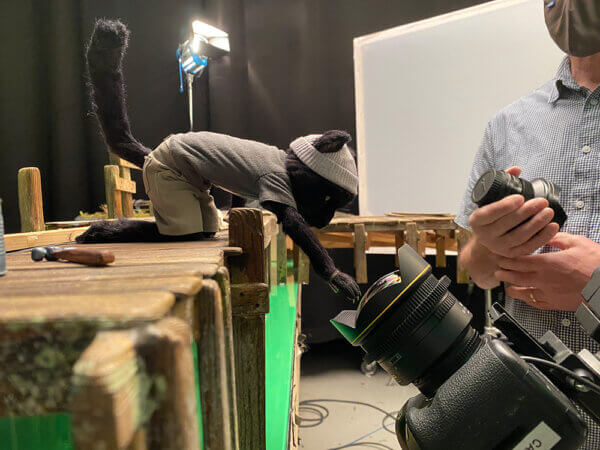
Behind the scenes of The House: Chapter 3 (Courtesy of Netflix ©2021)
I guess what really fascinates me about The House first of all is just where it came from as a concept and how you were brought on board. Was it a Nexus idea or did Netflix approach them with it…?
Paloma Baeza: It was actually Charlotte Bavasso at Nexus who had the crazy but brilliant idea to bring us together to come up with a concept that might be a trilogy of films. And she brought us together to brainstorm themes and characters that we might have in common, which was just a completely unique experience. You just never get to do that creatively, where you’re working closely with other creatives. It was so inspiring and lovely to be able to share different perspectives and we each had such admiration for each other’s work. We come from slightly different places, but have lots of overlaps, so it was really exciting. Then the concept of the house came out a little bit after that brainstorming session, it sort of evolved a bit from that after we all went back to different countries as it were, because we’re all remote, and then the house seemed like the perfect concept in which to set three completely different stories, but also have the overlaps we were looking for in terms of themes and tone.
Had you worked at all with each other before?
Emma De Swaef: No. This Magnificent Cake and The Burden I think had a cinematic release in the States together…
Niki Lindroth von Bahr: I really admire both Paloma and Marc and Emma’s work. I was quite nervous prior to working as a group, because where could I possibly fit in with this crazy talented bunch? But it’s been just such a good situation to just be able to support each other and give each other creative input. It’s been so much more comforting and fun to share it with the other directors.
It was definitely a really encouraging thing to see that it was you all involved as a group. As Nexus cover the whole gamut of animation production methods was it always an important factor for The House to be stop-motion?
Marc James Roels: I think that’s one of the main reasons why Charlotte put us together, because we all do the same thing and we each kind of do our own thing. So it’s something that you can kind of wrap your head around, it all kind of fits into a concept and being this house setting, I think that really kind of made sense for it to all be in the same medium.
EDS: It definitely would have been easier for Nexus to have chosen a different medium in Corona time!
I had gone into it thinking it was going to be episodic. Was that ever a plan or was it always going to be one feature-length anthology?
MJR: It’s kind of something in between, in that none of the stories have separate titles that appear or anything like that – it’s something quite unique. It obviously is an anthology, but the films are tied much more closely together than your typical anthology film where you’ve just got every filmmaker doing their own thing, completely separate from one another. With us, even though we weren’t dictating what the other was doing, we were kind of aware of what everyone was doing, so it did kind of seep into our stories. And that’s kind of why we feel there’s a more natural arc to the whole piece.
NLVB: Yeah, it felt kind of organic, because we worked quite separately with our stories and the scripts and everything, but since this has been in the back of our heads constantly and we’ve been in contact and sharing each other’s work, I think it just happened in a natural way, like you said, Mark, and I think that’s maybe the best way to do it. I think it worked out even better than I imagined. It’s really fun to try this format.
MJR: It’s kind of like the Exquisite Corpse idea, except that we knew what everyone was doing. We were also discussing previous Netflix anthologies like Love Death + Robots, but we didn’t want to do that either; that’s its own thing and we wanted to do our own thing. So we kind of settled on this without really ever going into specifics about the ‘how’ – we just kind of thought Well, let’s just write these stories. Let’s just see how everything falls into place – or not – and just kind of take it from there.
Can you tell us a bit about your respective story development processes? I know you mentioned there was some brainstorming at the beginning, but when it came to each chapter, was it more individual or based on any pre-existing ideas that you’d had?
PB: I suppose it’s different for each of us. It’s interesting how you arrive at a story, and I think you always do look at if there are any pre existing ideas that you want to explore. Thematically, there were some things around mothers and daughters, but actually where I’ve ended up is not really about mothers and daughters – in a way it’s about a person who’s a bit displaced in terms of relationships. Some of the things remain from my initial concept of relationships, but I think there was a proper development in terms of the narrative. And that came both from working with Enda Walsh, the writer, and also that we were very free in terms of what we were doing. Story-wise, there’s a structure, there’s a format, it’s half an hour and it is part of a trilogy. How much, for example, does the house feature in the story? I think probably in my very early stories it almost didn’t feature enough, because I took the character out onto the floods (my house is set in a flood) and so I ended up bringing the character back into the house, because actually you do need that containment and it really functions very well. I think that’s one of the things that links the three stories together so well, that you really do feel that the house is a character. So making that house sit right as a character within the stories was something that we all looked at. So a slightly different process for each of us, but certainly in the script stage that was one thing that, now looking back, I can see the evolution of.
EDS: For us, it was a bit different. When we came to the meeting, the only thing we really had was this idea that we’d had for a children’s series about two boys in a house where things come to life, so we just put it on the table. I think that’s one of the things that brought this house idea – what if we all do something in that location? But then coming home, we thought Well, it doesn’t really make sense to do something that has kids as main characters. So the story that we’d brought to the table at that point, we just completely dropped. Then I gave birth to our daughter and at that point this idea came to us to do something about the origin story of the house, something about a family who has a newborn daughter. . We had a synopsis that we came to Enda Walsh with and then, in collaboration with him, it took shape.
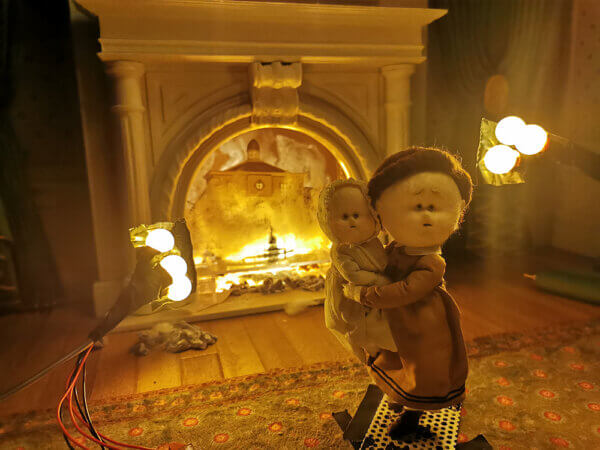
Behind the scenes of The House: Chapter 1 (Courtesy of Netflix ©2021)
NLVB: On my end, usually when I start thinking about a new project or a new film, I always start with the actual setting, the environment – that’s always been my main character. So I very much started with this house, and I was quite influenced by this overheated real estate business that’s going on, how our basic needs – like a home – have all of a sudden become this sort of status marker. Sidewalks here in Stockholm and everywhere are just crowded with trash bags, with everyone tearing out their high-functioning kitchens because they want a new one, it’s just so ridiculous. So I was quite interested in going a bit deeper into that theme, but also I wanted to make something perhaps even darker than I have worked on before. So I was quite influenced by, or inspired by, apartment thrillers like The Tenant and Repulsion and also David Lynch’s work in general. I came up with this idea about this sort of journey into inner – and outer – madness, while being isolated and very much under pressure and also within this extremely soulless, ‘Kylie Jenner’ mansion, what that could do to a person. So I came up with that idea together with a Swedish director and filmmaker, Johannes Nyholm, and then went on to develop it further with Enda, and I also had a great time working with him. He was so great at finding the story and the arc, it was a really fun thing to work with.
PB: It’s a very difficult task for any writer to come on board with three very different stories and perspectives. And also the aesthetic in each story is quite different, and we were originating the ideas so it wasn’t Enda just going “I’ll write a script about something I want to write about”. I wouldn’t want to speak for Enda, but he’s done a bit of acting and he often says that this was like an acting job, because it was like he was embodying each of our voices, and he really embraced that, which is rare. So he was a great collaborator in that respect, he just dove into the challenge.
Once it’s being animated, then, is the production taking place in different locations? Or is it all under one roof?
MJR: Yeah, it was all shot in Mackinnon & Saunders in Altrincham near Manchester. The shoots were sort of staggered, but still there was some overlap. So at one point, all three of the stories were being shot at the same time, occupying various parts of the studio. But yeah, even though we’re the first story we were the last to shoot, so we had to sweep up at the end (laughs).
EDS: And we’re sharing crew and we’re sharing animators…
MJR: The crew was kind of one constant, moving through all the films, so by the time they got to us their fingers were warmed up.
PB: There was this magical moment where it was the tail end of Niki’s, maybe she had one or two units. And then Marc and Emma were gearing up so their units were increasing. And I was in the middle, so I was shutting some down, but you could basically step through these different curtains and there would be a whole other world – it was three completely different universes. It was great.
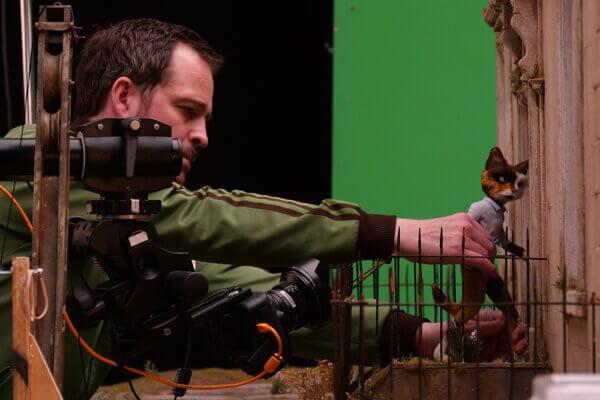
Behind the scenes of The House: Chapter 3 (Courtesy of Netflix ©2021)
Each segment has its own distinct stamp on it, they all do feel like films from each of you, but there is that sort of through line of consistency. Was having that crew overlap helpful in that respect?
PB: What mainly helped from the very beginning was having Alexandra Walker as our production designer. We had all had long discussions about what the house would look like. We had a design which she then adapted to each story, so you can recognize the house, despite the fact they’re different aesthetics, you can recognize the staircase in each story. Which means that, even though they’re very different, you have some hard, consistent structures that are instantly recognizable.
Of course, the films are often populated with characters that have either felt or fur, which is a material quality of stop-motion animation that you’ve all kind of led the charge on. And it’s been so embraced, like it’s everywhere now. I’m sort of interested in your perspectives on that, to look on and see this amazing ripple effect.
MJR: We never thought about that at all. It seems now, looking back, that it was the only logical way forward for stop-motion. Before that you had companies like Laika who were trying to refine it to the point where it’s indistinguishable from CG animation. So for us, we were looking at that going “Well, we can’t do that, we don’t have the means to do that”. So the only way we could think of was to use the most cost-effective materials that we could find. All the things that have made our films what they are were happy accidents that we embraced and tried to refine; when we were using felt, we never anticipated it looking the way it did. And we were pleased with that enough to refine it and go further with it. So we never really had this plan of “We’re going to do it like this and knock everyone’s socks off”.
EDS: It was more like “We have these puppets, maybe we can make films with them” more than “We need to make a film, what style shall we choose?”
MJR: We tried plasticine and latex and everything, but it really wasn’t so easy for us to work with, so we did the next best thing.
EDS: You really want to be aware that what you’re looking at is puppets, and the imperfections in the textures make you aware of it. That’s kind of the fun-ness of it. It’s also part of the reason why ‘behind the scenes’ for stop-motion are so popular. People want to see how things are made, how hand-made it is, how inefficient it is and how wonderful it is.
NLVB: I do think that there’s something so nice, to really get that tactile and organic feeling using materials that are close to perfection, but still with some cracks that make it so much more alive, and that you as an audience can, in some way, ‘feel’ the actual hours and tears and sweat.
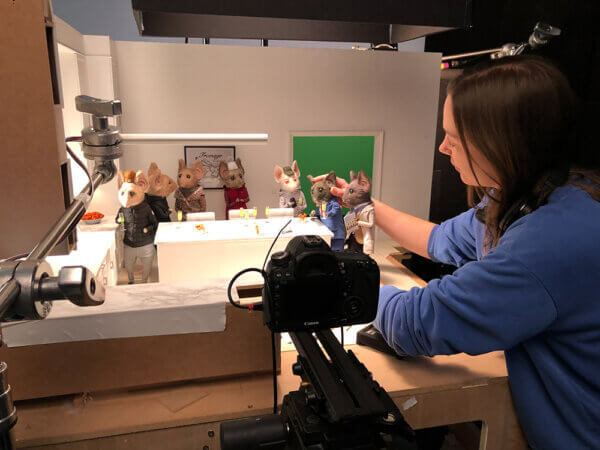
Behind the scenes of The House: Chapter 2 (Courtesy of Netflix ©2021)
And as we mentioned before, stop-motion isn’t really kind of given the same safety net that digital animation has when it’s come to remote working in the pandemic. Did COVID significantly impact the production of The House?
EDS: The way production handled this is absolutely astounding, like how well they just managed to turn everything around very quickly. One advantage is that we all were in different countries, so there was already kind of a remote setup from the start anyway. But then, of course, going into production, that wasn’t the plan at all. And Mackinnon & Saunders suddenly could have far fewer people in one space, lots of driving around with puppets and sending packages back and forth. So there was a huge impact. But we felt it very little because production was handling it so well. We would have liked to have gone to Manchester earlier, and for longer, that would have been ideal.
MJR: There was a brief moment of panic because no one knew what was going to happen, but they found their feet so quickly that before we knew it we were shooting – and having things shoved up our noses all the time – and it was amazing that it held together right through to the end. There was always this fear at the back of our heads that any minute it could shut down again, if some people started getting sick.
EDS: I mean, those moments at the end of production, where people are going for a drink, or you’re seeing someone outside, and they take off their mask and you’ve just never seen the bottom half of their face! And it’s kind of what you imagine, and some people not at all. It’s kind of a strange way to not know your crew members in that way, or not know their faces.
NLVB: I can’t imagine what kind of hell all of the people coordinating this must have gone through, because I don’t feel that I was the one getting most affected by it. It must have been such chaos, especially since everything has been changing from month to month. “Is it lockdown? Is it not lockdown?” But it’s still been the most fun years of my life, even with this chaos, it was still just the most lovely experience.
PB: I think we all feel really grateful to have had this to manage and manage it well, at least it’s a great distraction.
NLVB: Totally. I recommend it!
Were there any other challenges on the technical side of things that came up? Or new territory? I mean, you’re all veterans at this point, but it is quite a complex production…
PB: I had much more post production elements – I’ve never shot so much green screen! So that, for me, was my biggest fear/challenge/anxiety, I think. It’s quite challenging, because I had water and mist and furry puppets on top of all that, so I didn’t make life very easy for anybody. But in the end I’m really glad that I didn’t shy away from the challenge, because you end up just learning so much. So, yeah, it was a massive leap of faith, but the visual effects team were terrific and it was a real collaboration of technical know-how and sort of a vision of trying to make things feel real, despite the fact it’s a very unreal world. So that was a great challenge – sometimes I would be walking around looking quite stressed. But I’m not anymore. I’m quite pleased now!
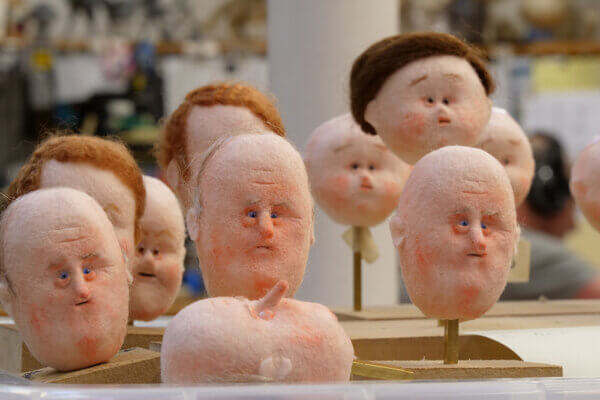
Behind the scenes of The House: Chapter 1 (Courtesy of Netflix ©2021)
From the Netflix end, is there hope to do similar things in this vein down the line?
NLVB: Yes please, Netflix! We’d love to. It was such a lovely surprise for me. I didn’t really know what to expect fully when going into this kind of project, compared to being alone in your basement and having control over everything, but I’m just so happy that we got this artistic freedom all through and they’ve been so supportive. I was quite surprised by that, to be honest. I think it’s amazing and I really hope that this will continue for us or other directors.
EDS: We really hope that they continue taking risks, believing in people and giving them the creative freedom that they did us – and that there’s a place for adult animation that there hasn’t been before.
The House is out now on Netflix.

